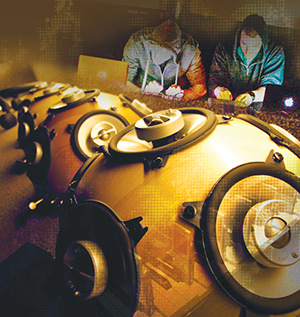It wasn’t that long ago when all music was made by acoustic instruments—vibrating strings, oscillating reeds and resonating wood. Our musical devices were powered by wind, friction and other forces. But today, whether you’re scanning the radio or browsing a web-based streaming service, chances are high that at least a portion of the music you’re encountering was produced through some form of synthesis.
The wobbling bass of that dubstep drop, the bowel-rattling kick and the snapping snare on that hip-hop beat, the impossibly rapid, arpeggiated guitar lick—all of them produced by a synthesizer. Even the resonant tone of that piano could as easily come from a Mac as from a Steinway.
Musical synthesis has been around for more than half a century. The theremin—most commonly used in cheesy horror movies and perhaps most famously deployed in “Good Vibrations” by The Beach Boys—was first pioneered in the 1950s. Robert Moog’s namesake machine was made famous by Wendy Carlos’ seminal 1968 album, Switched on Bach.
But the theremin was nearly impossible to master and the first generations of Moog synths were the size of refrigerators. By the late ’70s and early ’80s, plenty of professional musicians had access to synth keyboards and drum machines, but the cost of these devices limited electronic music to an elite cadre of artists.
Quite a bit of ground has been covered between then and now. Today, anyone with a smartphone, tablet or laptop can wirelessly download a powerful synthesizer.
Much of the musical technology we now access through our keyboards and touch screens can be traced back to Stanford in the late ’60s and ’70s, when a small group of dedicated musical hackers, who began tinkering with the university’s massive computers—learned to write code that produced beautiful sounds instead of cracking quantum quandaries.
This small cohort of mathematically minded musicians laid the groundwork for what is now known as the Center for Computer Research in Music and Acoustics—also known as CCRMA (pronounced “karma”).
Today, CCRMA conducts extensive research into how sound operates. Researchers at the center spend their time diagraming the acoustical fingerprint of famous rooms, so that one day you may be able to not only see the Taj Majal with the aid of virtual reality—but also hear what it sounds like to be in the space. They make instruments that you play like a video game and have doctoral candidates like Holly Herndon—an experimental electronic musician respected in both academic and indie music circles.
But perhaps most importantly, the CCRMA laid the groundwork for the popular electronic music revolution, by creating the protocol—FM synthesis—that led to the most popular synthesizer of all time, the Yamaha DX7.
Andrew J. Nelson’s new book, The Sound of Innovation: Stanford and the Computer Music Revolution, maps CCRMA’s history and its role in shaping the landscape of electronic music production tools available today. In his book, Nelson traces a path from the CCRMA co-founder John Chowning’s discovery of FM synthesis in the late ’60s to Ge Wang’s laptop and mobile phone orchestras.—Nick Veronin
Read an excerpt from The Sound of Innovation by Andrew J. Nelson




